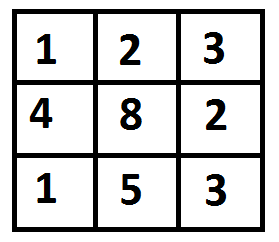给定成本矩阵 cost[][] 和在 cost[][] 中的位置 (m, n),编写一个函数,返回从 (0, 0) 到达 (m, n) 的最小成本路径的成本。矩阵的每个单元格表示遍历该单元格的成本。到达路径的总成本 (m, n) 是该路径(包括源和目的地)上所有成本的总和。您只能从给定的单元格向下、向右和斜下方的单元格遍历,即从给定的单元格 (i, j)、单元格 (i+1, j)、(i, j+1) 和 (i+1, j+1) 可以遍历。您可以假设所有成本都是正整数。
例如,在下图中,到 (2, 2) 的最小成本路径是什么? 
下图突出显示了成本最低的路径。路径是(0, 0) –> (0, 1) –> (1, 2) –> (2, 2)。路径的成本是 8 (1 + 2 + 2 + 3)。
# Dynamic Programming Python implementation of Min Cost Path
# problem
R = 3
C = 3
def minCost(cost, m, n):
# Instead of following line, we can use int tc[m + 1][n + 1] or
# dynamically allocate memoery to save space. The following
# line is used to keep te program simple and make it working
# on all compilers.
tc = [[0 for x in range(C)] for x in range(R)]
tc[0][0] = cost[0][0]
# Initialize first column of total cost(tc) array
for i in range(1, m + 1):
tc[i][0] = tc[i-1][0] + cost[i][0]
# Initialize first row of tc array
for j in range(1, n + 1):
tc[0][j] = tc[0][j-1] + cost[0][j]
# Construct rest of the tc array
for i in range(1, m + 1):
for j in range(1, n + 1):
tc[i][j] = min(tc[i-1][j-1], tc[i-1][j],
tc[i][j-1]) + cost[i][j]
return tc[m][n]
# Driver program to test above functions
cost = [[1, 2, 3],
[4, 8, 2],
[1, 5, 3]]
print(minCost(cost, 2, 2))
# This code is contributed by Bhavya Jain
输出:
8
请参阅关于动态规划的完整文章 |设置 6(最小成本路径)了解更多详情!
如果您希望与专家一起参加现场课程,请参阅DSA 现场工作专业课程和学生竞争性编程现场课程。